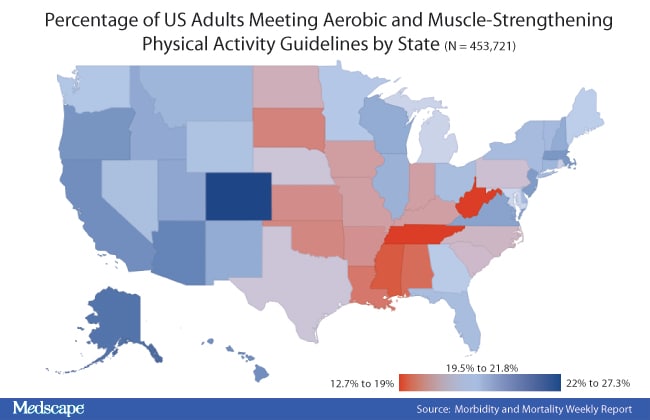Approximately 20% of American adults participate in regular aerobic and muscle-building activity, according to the findings of a survey by Carmen D. Harris, MPH, and colleagues from the Centers for Disease Control in Atlanta, Georgia, who published their findings in the May 3 issue of the Morbidity and Mortality Weekly Report.
In the study, the researchers used the Behavioral Risk Factor Surveillance System to collect data on aerobic and muscle-strengthening activity in all 50 US states and the District of Columbia. Respondents were considered to meet the guidelines for both aerobic and muscle-strengthening activity outside of regular job duties if they participated in 150 minutes or more of moderate-intensity aerobic activity per week, 75 minutes or more of vigorous-intensity aerobic activity per week, or a combination of moderate- and vigorous-intensity totaling 150 minutes or more per week as well as muscle-strengthening activity at least twice a week.
In 2011, 20.6% of American adults were found to participate in both muscle-strengthening and aerobic activity, including 17.9% of women and 23.4% of men. Hispanic adults (18.4%) were less likely to participate in these activities than non-Hispanic blacks (21.2%; P < .001) and non-Hispanic whites (20.7%; P < .001), and college graduates were more likely to exercise than high school graduates (27.4% vs 12.0%; P < .001).
In addition, underweight or normal-weight individuals (25.8%) were more likely to participate in muscle-strengthening and aerobic activity than obese persons (13.5%; P < .001), and participants aged 18 to 24 years were more likely to exercise than those older than 65 years (30.7% vs 15.9%; P < .001).

Among all the states and the District of Columbia, Colorado had the highest proportion of residents who participated in aerobic and muscle-strengthening activity, at 27.3%, whereas at 12.7% each, West Virginia and Tennessee had the lowest proportions of physically active residents.
Across the country, 51.6% of people met the criteria for aerobic activity compared with 29.3% of adults who participated in muscle-strengthening exercises, and the relationships of sex, gender, and body mass index with physical activity persisted for each individual activity.
The highest prevalence of aerobic activity (61.8%) was observed in Colorado, and the lowest prevalence was reported for Tennessee (39.0%). For muscle-strengthening activity, the District of Columbia had the highest prevalence of participation (36.1%), and West Virginians were least likely to participate (20.2%).
The limitations of the study included the self-report nature of the survey, which could lead to overestimation of activity; low response rate; and a lack of data on physical activity during work.
"Environmental and systems efforts involving communities, schools, governments, and worksites can increase opportunities for physical activity in adults," the authors write. "Continued national, state, and local efforts to implement strategies can help improve the proportion of adults who meet physical activity guidelines."
The authors have disclosed no relevant financial relationships.
Morb Mortal Wkly Rep. 2013;62:326-330. Full text
In the study, the researchers used the Behavioral Risk Factor Surveillance System to collect data on aerobic and muscle-strengthening activity in all 50 US states and the District of Columbia. Respondents were considered to meet the guidelines for both aerobic and muscle-strengthening activity outside of regular job duties if they participated in 150 minutes or more of moderate-intensity aerobic activity per week, 75 minutes or more of vigorous-intensity aerobic activity per week, or a combination of moderate- and vigorous-intensity totaling 150 minutes or more per week as well as muscle-strengthening activity at least twice a week.
In 2011, 20.6% of American adults were found to participate in both muscle-strengthening and aerobic activity, including 17.9% of women and 23.4% of men. Hispanic adults (18.4%) were less likely to participate in these activities than non-Hispanic blacks (21.2%; P < .001) and non-Hispanic whites (20.7%; P < .001), and college graduates were more likely to exercise than high school graduates (27.4% vs 12.0%; P < .001).
In addition, underweight or normal-weight individuals (25.8%) were more likely to participate in muscle-strengthening and aerobic activity than obese persons (13.5%; P < .001), and participants aged 18 to 24 years were more likely to exercise than those older than 65 years (30.7% vs 15.9%; P < .001).

Among all the states and the District of Columbia, Colorado had the highest proportion of residents who participated in aerobic and muscle-strengthening activity, at 27.3%, whereas at 12.7% each, West Virginia and Tennessee had the lowest proportions of physically active residents.
Across the country, 51.6% of people met the criteria for aerobic activity compared with 29.3% of adults who participated in muscle-strengthening exercises, and the relationships of sex, gender, and body mass index with physical activity persisted for each individual activity.
Information from Industry
The limitations of the study included the self-report nature of the survey, which could lead to overestimation of activity; low response rate; and a lack of data on physical activity during work.
"Environmental and systems efforts involving communities, schools, governments, and worksites can increase opportunities for physical activity in adults," the authors write. "Continued national, state, and local efforts to implement strategies can help improve the proportion of adults who meet physical activity guidelines."
The authors have disclosed no relevant financial relationships.
Morb Mortal Wkly Rep. 2013;62:326-330. Full text

No comments:
Post a Comment